Gould lobed bat
| Gould lobed bat | ||||||||||||
|---|---|---|---|---|---|---|---|---|---|---|---|---|

Gould's lobed bat ( Chalinolobus gouldii ) |
||||||||||||
| Systematics | ||||||||||||
|
||||||||||||
| Scientific name | ||||||||||||
| Chalinolobus gouldii | ||||||||||||
| ( Gray , 1841) |
The Gould's lobed bat ( Chalinolobus gouldii ) is a bat species from the smooth-nosed family (Vespertilionidae), which is native to Australia. The Greek genus name Chalinolobus refers to the typical skin flaps at the corners of the mouth of this genus, while the species name gouldii is dedicated to the English naturalist John Gould .
description
The Gould's lobed bat is the largest species of its genus with a head-to-trunk length of 65–75 mm and an average weight of 14 g. In some populations, the females are heavier than the males. In general, the weight changes over the course of the year: it decreases in late summer, while it increases again at the end of autumn and is highest in winter. The wingspan is about 30 cm. The fur is fine and silky, brown on the back and abdomen, while the head and shoulders appear black. Other species of the genus Chalinolobus are clearly more monochrome. The face is rather short and flat, with a wide muzzle. The nostrils point forward. The ears are short and rounded, with a long tragus . Its rear edge is extended downwards and forms a kind of wart at the respective corner of the mouth. A second flap of skin is on the lower lip. Two glands rise under the chin. The tail is completely embedded in the tail membrane and consists of eight vertebrae.
Way of life
The Gould's lobed bat, like most bats, is nocturnal and flies out around 20 minutes after sunset. The species flies quickly, but is less agile. The foraging takes place at a maximum height of 20 meters above the ground. The diet consists of insects, with moths making up the largest proportion. Chalinolobus gouldii produces loud, frequency-modulated echolocation calls. The lowest frequency of 29.6 kHz is just above the range that can be heard by humans, while the highest frequency is around 106 kHz. The Gould's lobed bat can be found in a variety of habitats, including forests and bushland, as well as in towns and villages. During the day, the animals hang mainly in the hollow branches of the red eucalyptus ( Eucalyptus camaldulensis ), under the roofs of buildings, in tree stumps and bird nests. The colonies consist of about 30 individuals with a maximum group size of up to 200 animals, with females being three times as common as males. While females show high fidelity to their colony, males have never been observed in the same group for more than a year. Hibernation is only kept in colder regions, while the animals in warmer regions are active all year round. In addition to echolocation calls, the Gould's lobed bat produces chirping sounds while in flight and various social calls when it is in the colony. If the species feels threatened, it emits a high, loud humming sound.
Reproduction
The mating season is between May and August. The females can store sperm in the reproductive tract for up to 33 days. The wearing time is about 3 months. Pregnant females have been observed in Victoria , an area with a Mediterranean climate, during September and October. Twins are mostly born, and newborn pups are found in November and December. The young are born naked, but develop a smooth, grayish coat as early as one week of age. After a month the young animals already look very similar to the adult animals. The animals reach their full weight after 2–3 months. The young stay in the mother's colony for up to a year.
distribution and habitat
The distribution of the Gould's lobed bat extends across Australia with the exception of the Cape York Peninsula and probably the Nullarbor Desert . It is also found in Tasmania , New Caledonia and Norfolk Island . Their populations are classified by the IUCN as stable and safe thanks to their widespread distribution, occurrence in a variety of habitats and relative tolerance to disturbances.
Web links
literature
- B. Chruszcz, RMR Barclay: Chalinolobus gouldii. Mammalian Species, No. 690, 2002, pp. 1-4.
